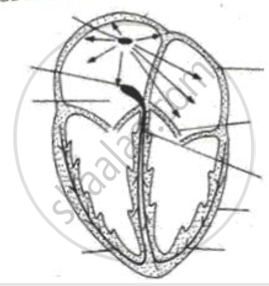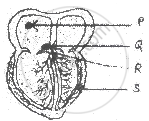Advertisements
Advertisements
प्रश्न
Give scientific reason.
Human heart is called as myogenic and autorhythmic.
उत्तर
- The heart shows autorhythmicity because the impulse for its rhythmic movement develops inside the heart. Such a heart is called myogenic.
- During development, certain heart muscle fibres become autorhythmic (self-excitable) and begin to generate impulses.
- These autorhythmic fibres have two vital functions: they operate as a pacemaker and set the heart's beat.
- They also form a conducting system for the conduction of nerve impulses throughout the heart muscles.
APPEARS IN
संबंधित प्रश्न
Multiple choice question. Tick (✓) the correct choice:
The heartbeat is measured by an instrument called
- thermometer
- sphygmomanometer
- stethoscope
- none of the above
Label the following diagram :

Draw the diagram of the Position of valves in the human heart.
State the Function: Pulmonary artery
The free edges of cuspid valves are attached to the papillary muscles of the heart by fibres are called ______.
What is the function of pericardial fluid?
Why are the walls of the left ventricle thicker than the other chambers of the heart?
Which of the following event occurs during ventricular diastole?
Observe the diagram, Identify the parts labelled as P, Q, R, S. Choose the correct option for the conduction of cardiac impulse.

Fill in the blanks of the following paragraph using just two words – arteries and veins.
___(a)___ carry oxygen-rich blood from the heart to all parts of the body and ___ (b)___ carry carbon dioxide-rich blood from all parts of the body back to the heart. ___ (c)___ have thin walls and __ (d)___ have thick elastic walls. Blood flows at high pressure in ___ (e)____. Valves are present in __ (f) ___ which allow blood to flow only towards the heart. __ (g)___ divide into smaller vessels. These vessels further divide into extremely thin tubes called capillaries. The capillaries join up to form ____ (h)_____.
